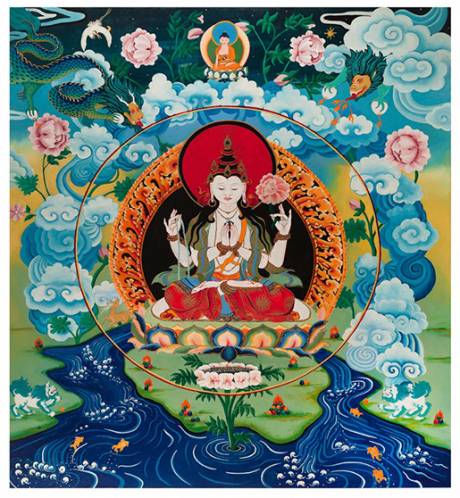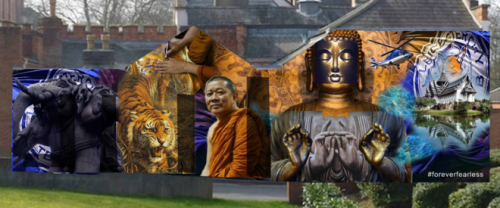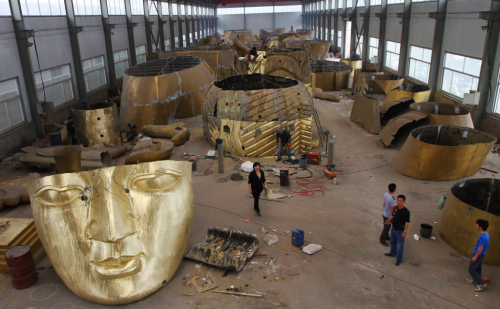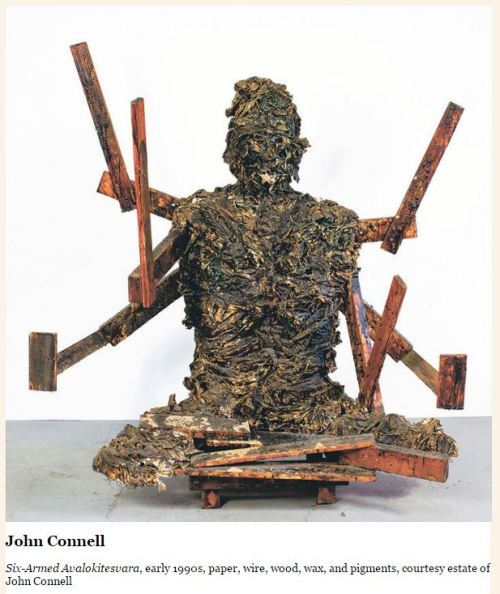
▼ Exhibit through Aug. 1
▼ Peters Projects, 1011 Paseo de Peralta [New Mexico], 505-954-5800
Pasatiempo
Friday, June 19, 2015 5:00 am
Michael Abatemarco
When Siddhartha Gautama, the historic sage who became known as Buddha, is depicted in meditation position, his left hand resting in his lap, palm upright, and his right hand touching the earth, the image represents the moment of his enlightenment. It also signifies his moment of triumph over Mara, the entity whose demonic forces were arrayed against Gautama to prevent him from reaching his goal. The paintings and sculptures of John Connell (1940-2009) are rooted in Buddhist tradition, and that mythic moment Gautama experienced under the bodhi tree is a subject Connell returned to time and again, not shying away from depicting the diabolical forces attempting to unseat Buddha from his immovable spot. Earth-touching Buddha, as the image is traditionally known, is steadfast in his devotion, calling on the earth to bear witness. It is fitting, then, that Connell’s own three-dimensional depictions of Buddha are often made using materials found just beneath one’s feet, or from deep in the earth, and sit in their place as naturally as boulders by a stream.
Connell’s legacy in New Mexico is apparent in a new monograph published by Radius Books, John Connell: Works 1965-2009, the most complete collection of his sculpture and paintings in print. “If you look in the section of the book, the ’60s and ’70s, you see a lot of Buddha things, and that developed all the way through his career,” Connell’s son Brendan Connell told Pasatiempo. “Probably something like 60 percent of his work has some relationship to some kind of a Buddhist theme, even if it’s not quite obvious from the titles.” In addition to the monograph, an exhibition of his works titled Earth-Touching Buddha is on view at Peters Projects as part of the gallery’s series of solo shows, Programme One, which opened on June 12. A look through Connell’s three-dimensional pieces makes it plain why the title is fitting. Not only are Buddha figures and related deities often the subject, but there is an earthy, grounded quality to the work. Many of Connell’s figurative sculptures, though abstract, seem rooted in place, like figures from the Buddhist pantheon who remain untouched by the efforts of their adversaries to disrupt them from their transcendent goals.
Bird sculptures on view in the exhibit, a common subject for the artist, have talons that are too large for their bodies. Feet, too big for the bodies they support, can also be seen in his depictions of human forms, lending some of his gnarly bronzes and mixed media works a certain bulk and weight. “Part of that with the sculptures was a technical thing to get them to stand,” Connell said. “He was at some museum where there were a number of sculptures by Giacometti, and he noticed that Giacometti had done the same thing, having these figures with very large feet. He realized it was something sculptors have been dealing with for a very long time. There is also some symbolism there, definitely.”
Connell first moved to Santa Fe for a brief spell in 1967 after living in Berkeley and working at San Francisco’s renowned City Lights Bookstore, where he fell in with Beat poets and writers such as Allen Ginsburg, Lawrence Ferlinghetti, and Neal Cassady. “Originally his aspiration was to be a writer, and he wrote numerous novels that were cast aside or thrown away. I’ve got a good body of his writing that, hopefully, I can get published somewhere,” Connell said. John Connell, who was a member of the Art Students League in New York in the early 1960s, most likely encountered his first real experiences with Buddhism while living in the Bay Area. “I recall him mentioning that he would read books by Alan Watts and people like that during downtime at City Lights. I believe at some point he also studied at the San Francisco Zen Center.” Connell met his wife, Stella, also employed at City Lights, who introduced him to the North Beach poets and soon, his own poetry began appearing alongside theirs in Beatitude Magazine, a seminal Beat publication founded by poets Bob Kaufman, Ginsburg, and others. Continue reading →
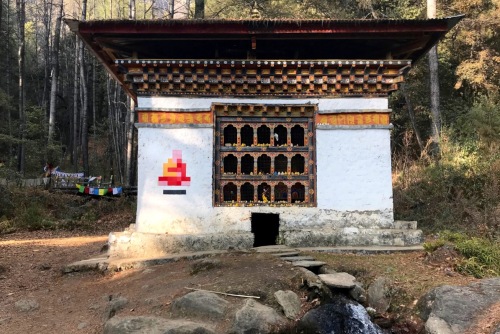 Lion’s Roar published a short piece (with lots of pictures on) in March on French street artist Invader’s work throughout Bhutan, painting and building Buddhist images in his bitmap style. “Famous street artist “invades” Bhutan with Buddhist-inspired mosaics”
Lion’s Roar published a short piece (with lots of pictures on) in March on French street artist Invader’s work throughout Bhutan, painting and building Buddhist images in his bitmap style. “Famous street artist “invades” Bhutan with Buddhist-inspired mosaics”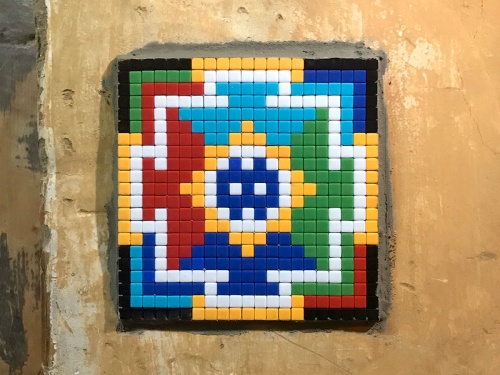

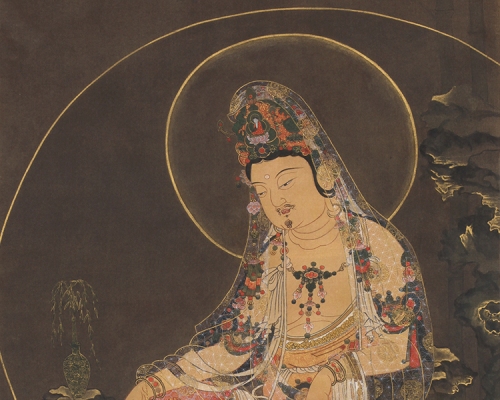 Flushing Town Hall (New York)
Flushing Town Hall (New York)
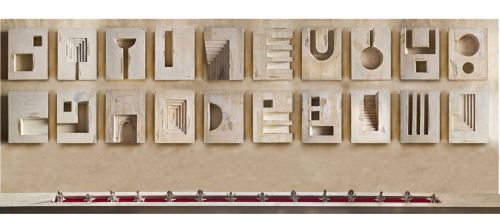
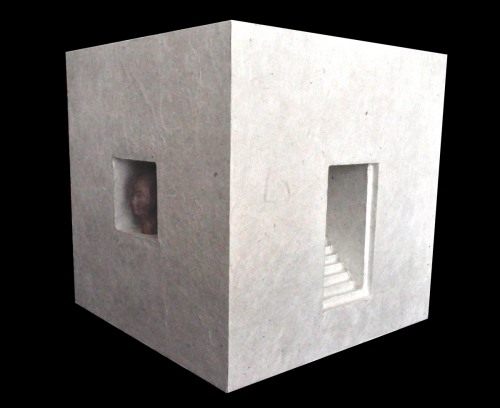
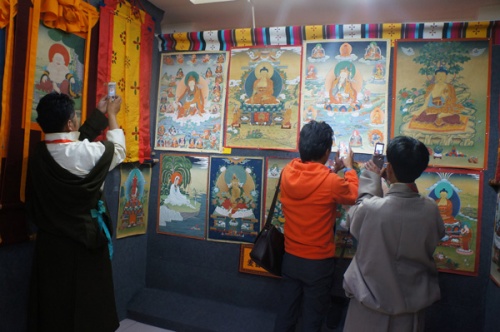 CCTV.com
CCTV.com